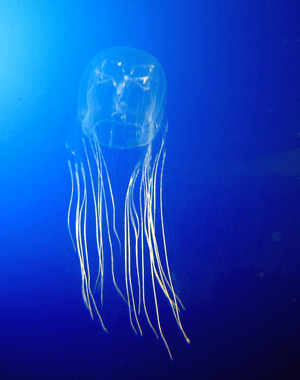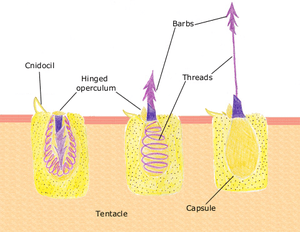Sea wasp sting
Background

Box jellyfish (Chironex fleckeri)

Nematocyst stages of discharge
- Chironex fleckeri, commonly known as sea wasp
- Large form of box jellyfish, found mostly off the coast of northern Australia to the Philippines
- Extremely deadly, often considered one of the most poisonous jellyfish
- Identification: Often difficult to distinguish in environment, as animal is transparent. Pale blue bell, often the size of a basketball, with 15 tentacles emerging from lower corners up to 3 meters in length. Has been described as having an eerie similarity to a human skull
- Tentacles contain millions of stinging cells known as cnidocytes
Clinical Features
- Sting is extremely painful, described as burning, and can cause death as quickly as 3-5 minutes
- Can cause significant hypotension, hypertension, cardiac arrhythmia, and cardiac arrest
- Most stings are mild and are self-limiting
- Deaths most commonly occur in children
- Venom causes cells to become porous and leaky, causing hyperkalemia
Differential Diagnosis
Marine toxins and envenomations
- Toxins
- Stingers
- Venomous fish (catfish, zebrafish, scorpion fish, stonefish)
- Cone shells
- Lionfish
- Sea urchins
- Nematocysts
- Coral reef
- Fire coral
- Jellyfish (Cnidaria)
- Portuguese man-of-war
- Sea anemones
- Phylum porifera (sponges)
- Bites
Evaluation
- Assess/manage ABCs
- ECG (look for arrhythmia, blocks, ischemia)
- CXR
- CBC, BMP, troponin/CK
- Consider:
- ABG, echo, nematocyst sampling
Management
- Address ABCs (e.g. CPR, fluid resuscitation, vasopressors, intubation as needed)
- Remove tentacles!!!
- Nematocysts can continuing firing and delivering more venom if tentacles still attached
- If available, pour lots of vinegar over tentacles first to inactivate
- Do NOT apply pressure dressing/immobilization (triggers nematocysts to fire)
- Box Jellyfish antivenom, if available
- Cardiac arrest: 6 ampules IV push
- Systemic envenomation with hypotension, collapse, or significant arrhythmia: 3 ampules in 100mL NS over 20m
- Pain refractory to opioids: 1 ampule in 100mL NS over 20m
- Magnesium sulfate: 10 mmol (~2-3g) IV if hemodynamically unstable
Disposition
This article is issued from
Wikem.
The text is licensed under Creative
Commons - Attribution - Sharealike.
Additional terms may apply for the media files.